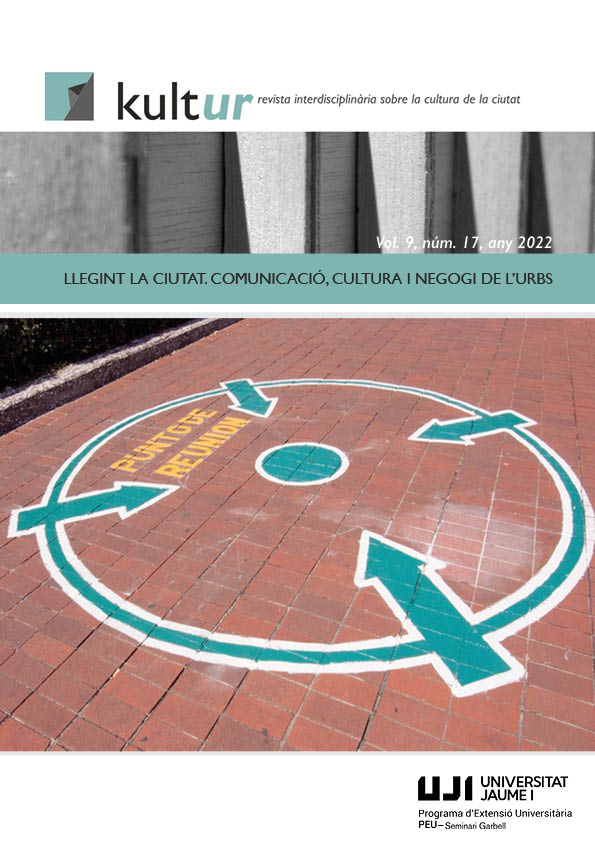Art and the urban environment. The power of representing, the power of keeping quiet
Main Article Content
Abstract
The urban sculptural art par excellence has always been the monument, with which we have coexisted in cities in an unequal but constant way. Political and cultural transformations affect not only the production of new monuments but also the perception of existing ones. Contemporary adjustments to monumental themes, formats and processes have led us to question their form and function as well as their location, even though we are living through a return to the old figurative models. On the other hand, we contemplate processes of dissolution of the monument in other relational forms more in keeping with democracy, drifting towards participation. All these reasons make it pertinent to reflect on the possible role of commemoration in our society and the consecration or disappearance of public spaces linked to it, as well as to both speculative and democratising processes.
Downloads
Article Details

This work is licensed under a Creative Commons Attribution-NonCommercial-NoDerivatives 4.0 International License.
All the contents of kult-ur journal are distributed under the Creative Commons Attribution-ShareAlike 4.0 International (CC BY-SA 4.0), unless otherwise indicated. Click to see basic information and the legal text of the license. The indication of this license CC BY-SA 4.0 must be expressly stated in this way when necessary.
References
Augé, M. 1993. Los “no lugares” espacios del anonimato. Una antropología de la sobremodernidad. Barcelona: Gedisa.
Blanco, P. 2001. Explorando el terreno. En VV.AA., Modos de hacer. Arte crítico, esfera pública y acción directa. Salamanca: Universidad de Salamanca.
Butler, J. 2004. Precarious life. The power of mourning and violence. Londres: Verso.
Brea, J.L. 1996. Utopia y Ornamento. Escultura en los años 80 y 90. En Arte, proyectos e ideas [Publicación periódica] nº 4, tomo I 1996 / Laboratorio Luz y Color. Valencia: Universidad Politécnica.
Candela, I. 2004. ¿Paz y prosperidad? Sobre la revisión crítica del monumento conmemorativo. En Ramírez, J.A; Carrillo Castillo, J ... [et al.], Tendencias del arte, arte de tendencias a principios del s. XXI. Madrid: Cátedra.
Canosa Zamora, E; García Carballo, Á. Enmascarando la pobreza del paisaje urbano: rotondas y arte público: http://age.ieg.csic.es/boletin/51/11-CANOSA.pdf
Carrillo, J. 2004. Habitar y transitar: reflexiones sobre los espacios de la vida en el arte actual cap. 4. En Ramírez, J.A; Carrillo Castillo, J ... [et al.], Tendencias del arte, arte de tendencias a principios del s. XXI. Madrid: Cátedra.
Delgado, M. 2004. La obra de arte en entornos urbanos. En Realitats de la ciutat, publicació editada por la plataforma Ciutadans per a una Cultura Democrática i Participativa. Valencia.
Durkheim, É. 2013. Las formas elementales de la vida religiosa. El sistema totémico en Australia (y otros escritos sobre religión y conocimiento) (1858-1917). México: Fondo de Cultura Económica.
Gómez Aguilera, F. Arte, ciudadanía y espacio público. En On the w@terfront n.º 5, marzo 2004 (36-51)
Jacobs, J. 2011. Muerte y vida de las grandes ciudades. Madrid: Capitán Swing.
Krauss, R. 1985. La escultura en el campo expandido. En Foster, H (Ed.): La Posmodernidad, Kairós, Barcelona,, págs. 63-64.
Laddaga, R. 2010. Estéticas de la emergencia. Buenos Aires: Adriana Hidalgo.
Lippard, L. R. Mirando alrededor: dónde estamos y dónde podríamos estar. En VV.AA., Modos de hacer. Arte crítico, esfera pública y acción directa. Salamanca: Universidad de Salamanca.
Lefebvre, H. 2017. El derecho a la ciudad. Madrid: Capitán Swing.
Maderuelo, J. 1990. El espacio raptado. Madrid: Mondadori.
Maderuelo, J. 1995. Cuatro modelos de recuperación de la obra de arte público. En Arte y espacio público : II simposio de arte en la calle / Fernández-Lomana, M.A; Salas, R (eds.) Santa Cruz de Tenerife : Universidad Internacional Menéndez Pelayo.
North, M. 1992. The Public as Sculpture: From Heavenly City to Mass Ornament, en VV. AA, Art and the Public Sphere, (W.J.T. Mitchell, ed.). Chicago: The University of Chicago Press.



.png)